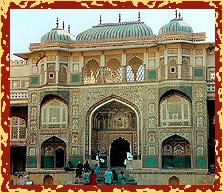Rajasthan Travels ::
Rajasthan Fort & Palaces ::
Amber Fort, Jaipur
Amber Fort, Jaipur

The Amber Fort in Rajasthan built in 1592 by Raja Man Singh, is one of the finest examples of Rajput architecture. Perched high on a barren ridge, it commands extensive views over a deep narrow valley and the wider plains beyond.
The building was finally completed in the early18th century when the threat of Mughal domination was receding. Amber was once, the capital of the Mina tribes, believed to be the original inhabitants of this region.
Located up on the hills that surround Jaipur, the fort, sprawled along the Maotha Lake, boasts of a massive complex gateways, courts, stairways and pillared pavilions, and palaces that recall the glory and wealth, of Amber's association with the Mughals. This complex was built by Raja Man Singh, Mirza Raja Jai Singh and Sawai Jai Singh, over a period of about two centuries.
Tribal and nomadic women are known for their love for silver jewellery (although men too sport ear studs and earrings). The ornaments follow age-old designs typical of a particular tribe. In daily use the ladies wear normal ornaments of neck, hand, nose and ear but on special occasions and social functions. Women wear all the ornaments of different parts of the body to look beautiful and attractive. For its exquisite designs and delicacy of art Rajasthan Jewelry is a rage not only for ladies of India but also for women of foreign countries.
The front courtyard of the complex, is adorned with the magnificent, pillared hall of the Diwan - i - Am, and the two - tiered painted gateway Ganesh Pol. The palace of mirrors, Sheesh Mahal, is of special interest. It has walls inlaid with exquisite mirrors. The Jas Mandir, perched on the upper floor, is a superb amalgam of Mughal and Rajput style of architecture, as is evident from the exquisitely carved Jali screens, and fine mirror and stucco work.
The fort is entered through the 'Dil-e-Aaram' Garden, laid out in the traditional Mughal style. An imposing flight of stairs leads to the 'Diwan-E-Am' (hall of public audience) which has latticed galleries and double row of columns each having a capital in the shape of elephants on the top. To the right are steps that lead to the small Kali Temple. Maharaja Man Singh was a great devotee of Goddess Kali and prayed to the goddess for victory during battles. The temple has huge doors made of silver. The larger white marble Shila Mata temple, has the image of Goddess Kali, brought by Raja Man Singh from Jessore in East Bengal (now Bangladesh).
s


 The Amber Fort in Rajasthan built in 1592 by Raja Man Singh, is one of the finest examples of Rajput architecture. Perched high on a barren ridge, it commands extensive views over a deep narrow valley and the wider plains beyond.
The building was finally completed in the early18th century when the threat of Mughal domination was receding. Amber was once, the capital of the Mina tribes, believed to be the original inhabitants of this region.
The Amber Fort in Rajasthan built in 1592 by Raja Man Singh, is one of the finest examples of Rajput architecture. Perched high on a barren ridge, it commands extensive views over a deep narrow valley and the wider plains beyond.
The building was finally completed in the early18th century when the threat of Mughal domination was receding. Amber was once, the capital of the Mina tribes, believed to be the original inhabitants of this region.